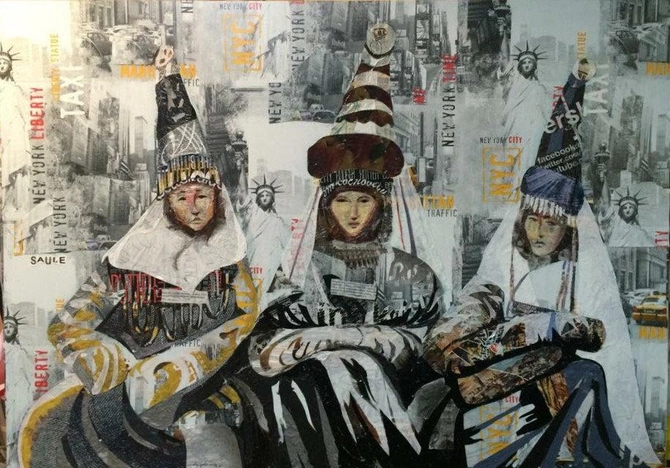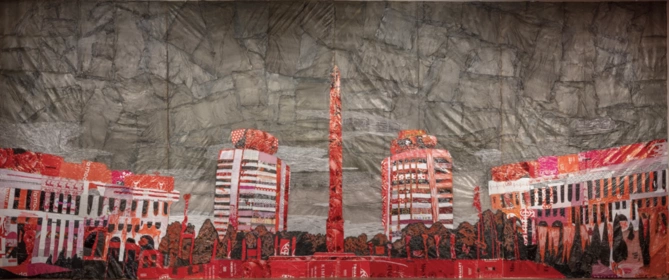
Meet the artist who is turning plastic bags into art and giving ordinary people a voice through her artworks.
Image: courtesy
“What is art?” Kazakh artist Saule Suleimenova asks. “It is to convey the beat of life. To convey something above all this fuss, digging in the ground.” Her works are testimony to her words. Starting at the end of the 1990s, Suleimenova created art in her hometown Almaty by experimenting, using different techniques, and focusing on a wide range of topics. From decolonialism and patriarchy to sustainability and overconsumption—she has shown it all through her works.
“At some point, any beauty becomes pop, banality. We all love sunsets, but at some point when it becomes the wallpaper on your computer desk, it becomes trivial,” the artist explains her desire to create works that have meaning and don’t turn into a cliché. “I want to convey what I’m worried about. I want to convey this excitement, delight, and ecstasy,” she explains. For her, in order for art not to become dull, “we need to look for a new way to convey it, a new language, a new technique.”
Her works are as far from cliché as possible. She uses such different techniques, such as grattography (paraffin engraving), painting on photographs (using documentary photos of a modern city with its real garbage), and her most famous technique, cellophane painting (using plastic bags, polyethylene, and polycarbonate).

Forever, Saule Suleimenova. Image: courtesy
Suleimenova first considered using plastic bags to create art in 2014. While she was riding the train from Almaty to Astana, she noticed the amount of colorful plastic scattered on the way. She saw this as a problem of overconsumption. “When I saw these bright colors of the plastic bags—so bright, glossy, intense—I thought, why buy paint, engage in this overconsumption again when so much water and material were already used [to make plastic]?”
However, three years passed from the idea’s conception to the actual opening of her first cellophane exhibition. “If you know, polyethylene or cellophane, this type of plastic does not stick to anything. Even the strongest construction adhesive will not stick; it only sticks at high temperatures. By the time I came to use the silicone blue gun, some time had passed,” she says.

Apa on the Cow, Saule Suleimenova. Image: courtesy
At first, many people in Kazakhstan didn’t understand the point of using ‘trash’ to create art. “Surprisingly, I can observe how, over these ten years, the attitude towards my cellophane paintings has changed. My first exhibition in Almaty was held by a novice art manager who liked my works and wanted to sell them so much. I told her that it’s not realistic… it takes time for people to understand it.” In the span of ten years, the artist went from her art manager going to the banks to try to convince them that Suleimenova’s works have value to people now telling the artist how valuable her works are.
“When I had an exhibition in Dubai at Andakulova Gallery, there were several programs and films that people made about sustainability and how my art is directly related to this. But I believe that art is always more than such agendas,” Suleimenova explains.
Although she is best known for her successful cellophane series, that is not her only work worth noting. Her focus on Kazakh identity, decolonialism, and political changes in the country, is what makes Suleimenova the greatest contemporary artist in Kazakhstan. Her works mirror the cultural and social changes and problems that her contemporaries are witnessing.

Three Brides, Saule Suleimenova. Image: courtesy
“I am very concerned about the issue of values. I have observed throughout my entire artistic practice how values change,” the artist explains. “Over the past 20 years, the running theme [in my works] is Kelin (Kazakh: bride), a girl on the threshold between childhood and independent life,” Suleimenova says, adding that this vulnerable period in the lives of young girls is often underestimated. That’s the main goal of her art—to give voice to the invisible and voiceless people.

The Bride, Saule Suleimenova. Image: courtesy
“Through art, the invisible can be made visible. You can give a voice to those who don't have one. It excites me so much. Therefore, I return to such social triggers and try through art, especially in cellophane painting, to highlight and show the beauty that people did not notice, did not see, did not appreciate.”
Her nineteenth personal exhibition, Biz Qarapayim Halyqpyz (Kazakh: We are ordinary people), was dedicated to the January 2022 unrest in Kazakhstan, also known as Qandy Qantar (Kazakh: Bloody January). The name of the exhibition derives from the protesters’ sign “We are ordinary people, we are not terrorists!!!” opposing President Tokayev claims. It was Suleimenova’s way of using her voice “on behalf of those who do not have this voice, or who fell at the Square.”
“After the Qantar, many were in serious condition, then the war in Ukraine added to that. It seemed to me that I had no right to remain silent. And if someone doesn't speak up, I must. To share feelings that I think were common to everyone,” the artist says. “In my main work, Sky Over Almaty, I specifically tried to avoid images of people and indications of some political attitudes. I wanted to convey this feeling of this impenetrable fog, this feeling that we are being ‘flooded’ with blood. I don't want to say these words because they become so flat compared to what we actually felt,” she explains.

Sky Over Almaty. Qandy Qantar, Saule Suleimenova. Image: courtesy
Suleimenova, who was born into a creative family, always felt like she was living in the shadow of her father, Timur Suleimenov, one of the designers of the first tenge and the head of the Union of Designers of Kazakhstan. “This was a big problem for me when I was young, but when he died in 2018, I accepted it as a given,” the artist shares. After putting so much effort into proving herself to her dad and others for many years, now, as an accomplished artist, Suleimenova asks herself if it was ever needed. Today, surrounded by her artist husband, daughters, mother, and grandson, Suleimenova proudly calls her creative family her art group and is proud of being surrounded by talented artists in her family.
Share on social media